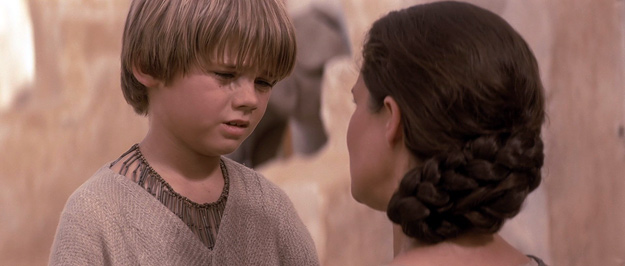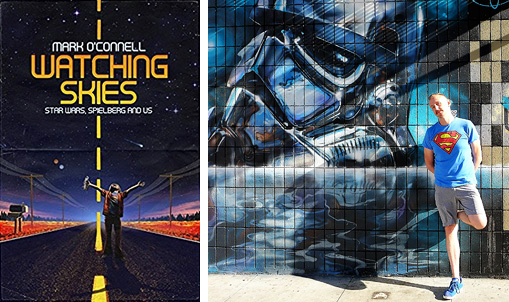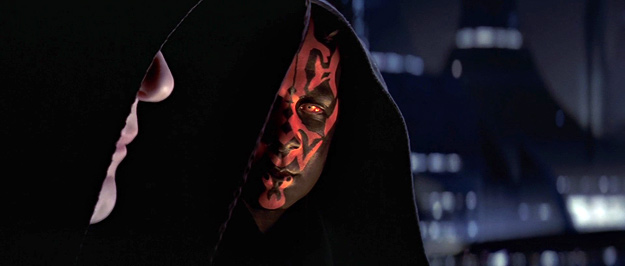
THE DIGITAL CINEMA ENGAGEMENTS
On June 18th, 1999, after four weeks of release (in 35mm), Lucasfilm and 20th Century Fox, in association with CineComm and Texas Instruments, introduced the Digital Cinema edition of The Phantom Menace, marking the introduction to what has evolved into the industry standard for theatrical presentation.
(Miramax attempted to steal some thunder from Fox and Lucasfilm by rush-releasing An Ideal Husband the same day in a rival system.)
The following were the theaters selected to screen the D-Cinema edition of The Phantom Menace. These presentations were screened four weeks at each venue. (This author saw it twice at the Burbank location.)
CALIFORNIA
- Burbank — AMC Burbank 14 [Texas Instruments]
- Los Angeles (Chatsworth) — Pacific Winnetka Stadium 21 [CineComm]
NEW JERSEY
- Paramus — Cineplex Odeon Route Four 10 [CineComm]
- Secaucus — Loews Meadows 6 [Texas Instruments]
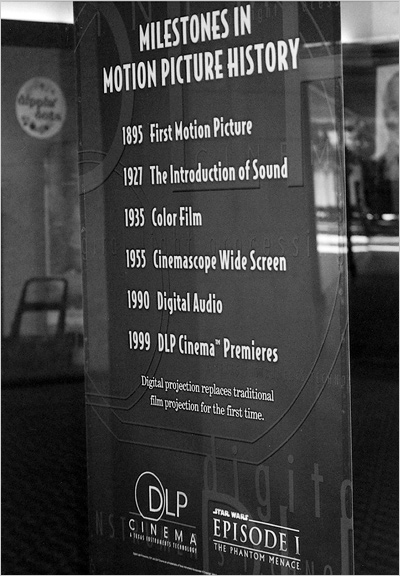
THE Q&A
Stephen Danley is a Moving Image Cataloger at the Academy of Motion Pictures Arts and Sciences and the owner/editor of Star Wars at the Movies, a “centralized resource which documents vintage and contemporary Star Wars theatrical advertising, collectible ephemera, and the saga’s original movie-going experience.”
W.R. Miller is the author of The Star Wars Historical Sourcebook: Volume One 1971 to 1976 (2018, Pulp Hero Press). The illustrator and storyboard artist is also the author of The Animated Voice: Interviews with Voice Actors, Volume One (2018, Pulp Hero Press) and May the Facts Be With You: 1200 Star Wars Stumpers for Serious Fans (2018, Pulp Hero Press).
Mark O’Connell is the author of Watching Skies: Star Wars, Spielberg and Us (2018, The History Press). The punditeer is also the author of Catching Bullets: Memoirs of a Bond Fan (Splendid Books, 2012).
The interviews were conducted separately and have been edited into a “roundtable” conversation format.
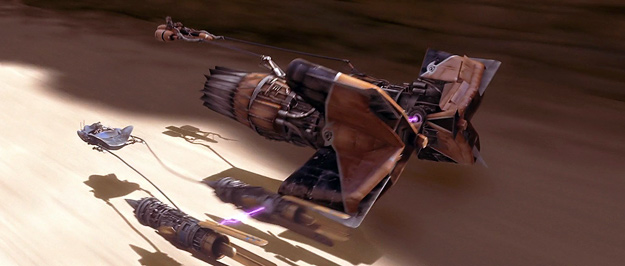
Michael Coate (The Digital Bits): How do you think Star Wars: Episode I—The Phantom Menace should be remembered on its 20th anniversary?
Stephen Danley: Perhaps more than anything, The Phantom Menace should be remembered for its boldness. Despite its undeniable shortcomings, the movie’s disregard for long-gestating fan expectations and safer crowd-pleasing formulas combined with its ambition to establish a visual language so vastly different from anything we’d seen in a Star Wars movie should be more appreciated, and it seems like over time it has. Out of any of the films, this one seemed to take the most risks. Some simply didn’t work, while others paid off (or were at least kind of interesting). It feels like a bizarre Star Wars period piece — almost like a serious historical space drama peppered with jarring juvenile humor. 20 years on, it should be remembered as truly one-of-a-kind.
W.R. Miller: To some fans, the question would be: should it be remembered?
It’s the first Star Wars film that caused a generation gap in Star Wars fandom. Generally speaking, those who grew up watching the original trilogy don’t like it; while the younger generation thinks it’s great. George Lucas admitted that to talk show host Jon Stewart on The Daily Show (1/5/2010, posted online at http://www.cc.com/video-clips/cb7lw3/the-daily-show-with-jon-stewart-george-lucas).
It should be remembered for merchandising overkill. The Toys That Made Us documented what happened when licensees flooded the market with Episode I toys — which didn’t sell as well as expected and so, they were dumped in remainder bins. The documentary correlated the lackluster sales to the film’s lackluster story and characters. Alan Hassenfeld, Hasbro CEO, 1989-2008: “Little did we know, though, when we’d started, there was going to be Jar Jar.”
Any remembrance of The Phantom Menace will be for Jar Jar Binks, for what happened to the actors who played Jar Jar and young Anakin, for its application of CG technology as an alternative to using models and “practical effects,” for the rousing score by John Williams, and for the flaws as stated in the review by Plinkett, sans profanity.
Mark O’Connell: With better love than it received at the time! The faults of The Phantom Menace are not just the mop-haired antics of a child Anakin, the endless talk of trade wars, Jar Jar Binks or the paralyzed performance from Natalie Portman. It is the dilemma of the prequel. George Lucas tasked himself with adding grammar to movie sentences already written. That is the nature of prequels, not some damning indictment against Mr. Lucas.
Coate: What do you remember about the build-up to its release and the first time you saw The Phantom Menace?
Danley: Having been in junior high school in the year leading up to its release, most kids my age weren’t aware of or all that interested in Star Wars, so I experienced Episode I’s build-up in relative isolation. I completely missed the first teaser trailer that many fans remember so fondly, but do recall getting pretty excited when checking out coverage in magazines like Entertainment Weekly and the Star Wars Insider. When the full theatrical trailer debuted online in the spring of ’99, I rode my bike to a nearby Gateway Computers store to try and discreetly watch it on one of their demo stations. After what seemed like hours of waiting for the file to download, QuickTime ended up only playing the audio! But even that was enough to get me pretty hyped. In fact, it was the prospect of downloading that trailer (and presumably future Star Wars trailers as the trilogy unfolded) that was actually behind my campaign for our family to buy a new computer and get high speed Internet. Enhanced and more efficient school-work would be a bonus! As for the first time I saw the movie, my mom had hatched a plan to pull my siblings and I out of school to catch an early morning opening day screening at the Arlington Theater in Santa Barbara, California, which is where I’d seen the original films on the big screen in a special triple bill in the early 90s and again in 1997 with the Special Editions. I remember being in a slight state of confusion up until the Pod Race, my sister-in-law (who’d graciously lined up to buy the tickets a day or two before) falling asleep during the initial senate scene, and being blown away by the lightsaber duel. I neither hated nor loved it, but did somehow end up going back to see if four more times that summer. It felt like the right thing to do.
Miller: By 1999 we had two generations of Star Wars fans: one which saw the original trilogy in theaters, and one which saw them on home video and in theaters as the Special Editions. Who didn’t want a return to that galaxy far, far away?
The Internet was in its formative years. It took a while to download the trailer due to the relatively slow baud transfer rates. It turned out to be a great trailer. In 1998, The New York Times reported people paying to see films like The Waterboy, The Siege and Meet Joe Black, then leaving the theater after they saw the trailer to Episode I.
Of course expectations were high. George Lucas had the latest special effects technology and over 15 years to conceive a compelling story. We wanted to experience the same fun and excitement and romantic appeal that Lucas had delivered in the original trilogy.
Or would our faith in him be shaken?
O’Connell: Going as a grown adult into a toy store and digging deep for Star Wars figurines. It was most surreal doing that again! I remember the constant magazine covers, and the Annie Leibowitz Vanity Fair cover shoot adding some class to the circus of tie-ins and random merchandise. A year or so before a pal had directed a BBC documentary look at George Lucas and it ended on a tiny peek of what was an irrelevant ship. That image stayed with me.
The Phantom Menace was the first Internet movie — in that it was the first real big event title to have its trailer online and get massively downloaded and discussed. This sky kid remembers New Year’s Eve 1998 and waiting for a pal’s PC to fully upload the trailer. It took hours. We would all come back to the room in various stages of alcoholic merriment to check on our trailer “dinner,” but it was never ready yet. When it finally uploaded, we all huddled around the monitor and watched and pored over a promising teaser that was about the size of a USB stick. For me, the film was never as good as the brilliance of that first effective teaser. And maybe the teaser was never really as good as that shadowed Anakin image. The soundtrack listings throwing a huge spoiler about Liam Neeson’s demise hardly helped either. I saw the film at my local cinema with a bunch of likeminded Star Wars pals on its opening Friday. It was a slightly sobering night as we all realised we were never going to be 8 years old again and maybe that had fed into our quietly collective conclusion it misfired on a few counts.
